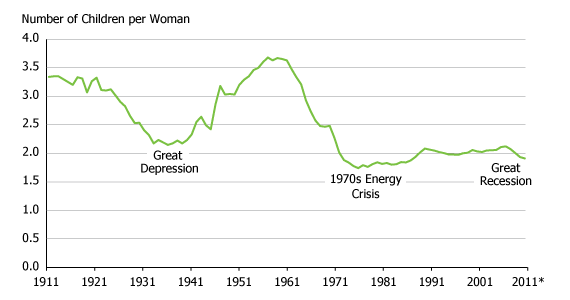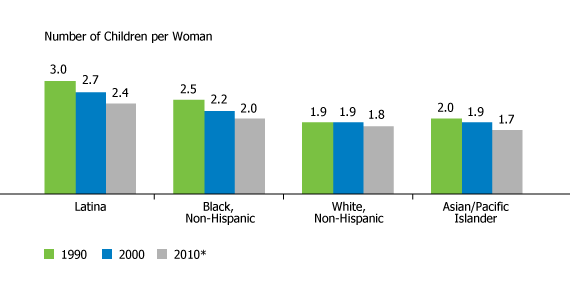Mark Mather
Associate Vice President, U.S. Programs

In the United States and other developed countries, fertility tends to drop during periods of economic decline. U.S. fertility rates fell to low levels during the Great Depression (1930s), around the time of the 1970s “oil shock,” and since the onset of the recent recession in 2007 (see Figure 1). The U.S. total fertility rate (TFR) stood at 2.0 births per woman in 2009, but preliminary data from the National Center for Health Statistics show that the TFR dropped to 1.9 in 2010—well below the replacement level of 2.1.1 A similar decline—or leveling off—of fertility rates has been reported in Ireland, Italy, Spain, Sweden, and several other European countries.
Figure 1
The U.S. Fertility Rate Has Fallen During Periods of Economic Decline

* Estimated by PRB.
Source: National Center for Health Statistics
This recent fertility decline may be just a short-term response to high unemployment rates, or it may signal a longer-term drop in lifetime fertility. Most recessions have had relatively minor effects on fertility rates—often lasting two to five years. Recessions generally affect the timing of fertility but not the overall number of children that women will have in their lifetimes.2 Longer-term trends in fertility are determined by broader societal factors, including trends in marriage; economic development; cultural norms; and women’s education, employment, and access to contraception. Although fertility rates bottomed out during the Great Depression, the birth rate had been declining throughout the 1920s—a period of rapid economic growth—as more couples used birth control to limit family size.3
The U.S. fertility rate is edging closer to TFRs in Europe, where many countries are grappling with very low birth rates (averaging 1.6 children per woman) and potential labor shortages.
Fertility rates in the United States have fallen since 1990 among all major racial/ethnic groups (see Figure 2). The Latina fertility rate dropped sharply in recent decades, from 3.0 births per woman in 1990 to 2.4 births per woman in 2010; and for black women from 2.5 to 2.0. Fertility rates among white and Asian women have also dropped, but at a slower pace, resulting in similar fertility rates among different racial and ethnic groups.
Figure 2
Fertility Rates for Latinas and Black Women Are Approaching Those of White and Asian Women.

* Preliminary data.
Source: National Center for Health Statistics.
Relatively high unemployment rates among African Americans and Latinos may have played a role in the recent fertility decline—especially among those with less education and lower incomes.4 But increasing college attendance, especially among women, is another potential factor. Education affects the timing of marriages and first births, typically delaying both. Thus, the U.S. fertility rate may drop further if the share of women attending and completing college continues to increase. Among 18-to-24-year-olds, more women than men are enrolled in college in every racial and ethnic group.5
A prolonged decline in African American and Latina fertility rates will affect the future racial and ethnic composition of the United States. The Census Bureau recently reported that over half of all U.S. infants are racial/ethnic minorities.6 The U.S. population is currently projected to reach “majority-minority” status (the point at which less than half of the population is non-Hispanic white) in 2042. For several decades, immigration has been the driving force behind rapid racial/ethnic change in the United States, but a sustained drop in fertility rates could slow the pace of growth of the country’s minority population.
The decline in U.S. fertility has been driven primarily by a trend among young adults to postpone having children. Forty years ago, birth rates among women in their 20s were significantly higher than those of women in their 30s. In 1970, there were 168 births per 1,000 women ages 20 to 24, compared with 73 births per 1,000 women ages 30 to 34. However, this gap has steadily narrowed over time. By 2009—for the first time in U.S. history—birth rates among women ages 30 to 34 (97.5 births per 1,000 women) exceeded those for women ages 20 to 24 (96 births per 1,000 women). In 2010, the birth rate among teens dropped to 34 births per 1,000 girls ages 15 to 19—the lowest level ever recorded in the United States.
This recent drop in births among young adults could be linked to the recession. In Europe, high rates of unemployment and low levels of economic security are strongly associated with declines in fertility among young adults.7 The economic downturn may have had a similar effect on young adults’ fertility in the United States.
However, longer-term fertility trends may depend on future trends in women’s employment and earnings relative to men.8 Women outnumber men in college and make up a growing share of the labor force. The recession hit male-dominated jobs the hardest, contributing to a growing share of women who now outearn their husbands.9 As more women become primary breadwinners, fertility decisions are more likely to hinge on women’s earnings than they did in previous decades. A growing reliance on women’s employment and earnings could further dampen U.S. fertility rates in the coming decades.
